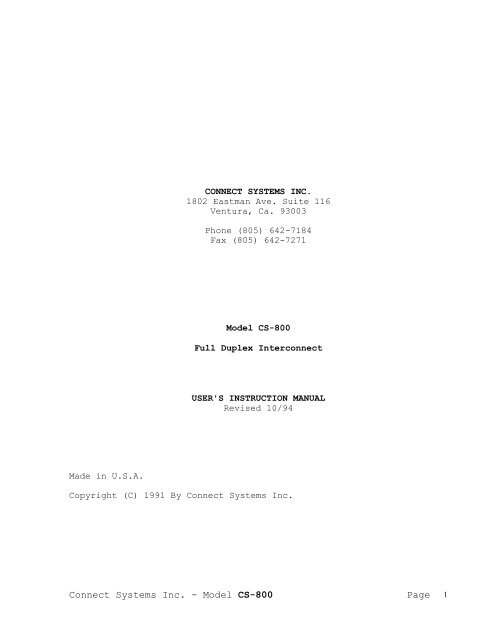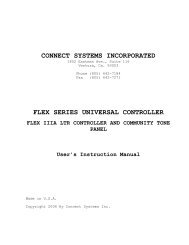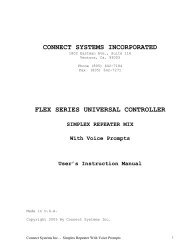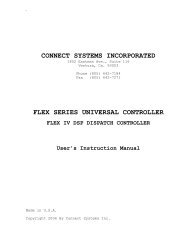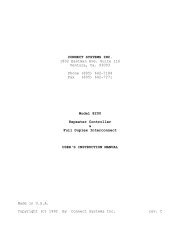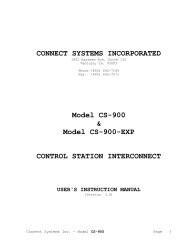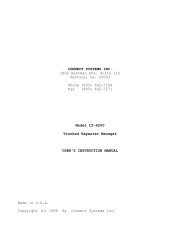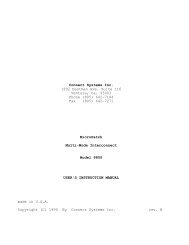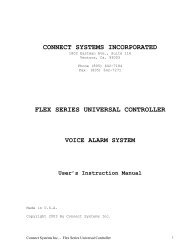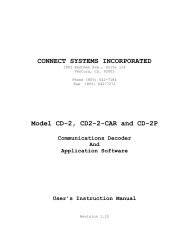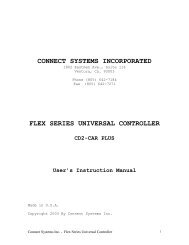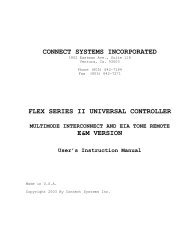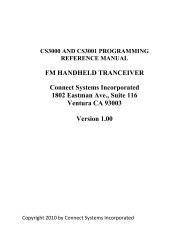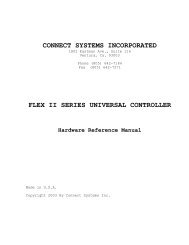Model CS-800 FULL DUPLEX INTERCONNECT - Connect Systems
Model CS-800 FULL DUPLEX INTERCONNECT - Connect Systems
Model CS-800 FULL DUPLEX INTERCONNECT - Connect Systems
You also want an ePaper? Increase the reach of your titles
YUMPU automatically turns print PDFs into web optimized ePapers that Google loves.
CONNECT SYSTEMS INC.<br />
1802 Eastman Ave. Suite 116<br />
Ventura, Ca. 93003<br />
Phone (805) 642-7184<br />
Fax (805) 642-7271<br />
<strong>Model</strong> <strong>CS</strong>-<strong>800</strong><br />
Full Duplex Interconnect<br />
USER'S INSTRUCTION MANUAL<br />
Revised 10/94<br />
Made in U.S.A.<br />
Copyright (C) 1991 By <strong>Connect</strong> <strong>Systems</strong> Inc.<br />
<strong>Connect</strong> <strong>Systems</strong> Inc. - <strong>Model</strong> <strong>CS</strong>-<strong>800</strong> Page 1
TABLE OF CONTENTS<br />
General Description ............................... 2<br />
Installation and Adjustments ...................... 3<br />
Programming Procedure ............................. 8<br />
Operating Mode Programming ........................ 9<br />
CW ID Programming ................................. 16<br />
Speed-dialer Programming .......................... 18<br />
Access code programming ........................... 19<br />
OPERATION ......................................... 21<br />
Placing outgoing calls ......................... 22<br />
Incoming calls ................................. 23<br />
Options:<br />
Auxiliary Relay ................................ 25<br />
Warranty .......................................... 26<br />
Appendix A FCC Notice to Users .................... 27<br />
Schematic Diagrams ............................. 29- 30<br />
Addendum; External <strong>Connect</strong>ion Method .............. 31<br />
Glossary .......................................... 32<br />
-----------------------------------------------------------------<br />
GENERAL DESCRIPTION<br />
The <strong>Model</strong> <strong>CS</strong>-<strong>800</strong> <strong>FULL</strong> <strong>DUPLEX</strong> <strong>INTERCONNECT</strong> by <strong>Connect</strong> <strong>Systems</strong> Inc. is<br />
an economical <strong>FULL</strong> <strong>DUPLEX</strong> radio-telephone interconnect terminal. A<br />
built-in keyboard and digital display readout allow the user to obtain<br />
the maximum power from the on board microprocessor. All features are<br />
user programmable and/or selectable.<br />
Powerful built-in standard features such as... 9 number speed dialer,<br />
last number redial, remotely controllable relay, automatic disconnect<br />
on busy signals and dialtone, fully regenerated tone or pulse dialing,<br />
etc. make the <strong>CS</strong>-<strong>800</strong> the best deal going in Full Duplex interconnects<br />
today!<br />
Designed and made in the U.S.A.<br />
<strong>Connect</strong> <strong>Systems</strong> Inc. - <strong>Model</strong> <strong>CS</strong>-<strong>800</strong> Page 2
INSTALLATION AND ADJUSTMENTS<br />
When making up your interface cabling, please use shielded wires with<br />
the shields at both ends connected to chassis ground. (The rear panel<br />
barrier strip terminals labelled "GND" are chassis ground). We<br />
recommend using spade type crimp-on connectors for ease and<br />
reliability. <strong>Connect</strong> the center wires as follows:<br />
AUDIO IN:<br />
The audio input terminal may be connected to the<br />
discriminator output, or to the high end of the volume<br />
control.<br />
Cut JP-1 if connection is made to the high end of the<br />
volume control. Leave JP-1 installed if connection is<br />
made to the discriminator.<br />
COS:<br />
The COS input can be connected to the noise squelch for<br />
carrier operation, or to the DPL/CT<strong>CS</strong>S squelch if you<br />
want the radios' built-in decoder to provide private<br />
operation.<br />
Noise Squelch <strong>Connect</strong>ion: <strong>Connect</strong> to a point that has<br />
considerable voltage swing when the squelch is<br />
opened/closed. The best point to connect is to the<br />
collector of the transistor that controls the busy (or<br />
receive) light (if the radio has one). Otherwise, connect<br />
to the output of the noise rectifier.<br />
DPL/CT<strong>CS</strong>S Squelch: The receiver's DPL or CT<strong>CS</strong>S decoder<br />
will have a logic output that goes high or low when a<br />
properly encoded signal is received. <strong>Connect</strong> this point<br />
to the COS input.<br />
If the point selected goes more positive (voltage<br />
increases) when a signal is received, leave the factory<br />
installed push-on clip on JP-2. If the point goes to a<br />
lower voltage, remove the JP-2 clip which will invert the<br />
COS signal from the receiver.<br />
When the COS threshold control P5 has been properly<br />
adjusted (described below), and the correct polarity<br />
selected at JP-2, the front panel RX LED will illuminate<br />
when a signal is received, and go out when the signal is<br />
removed. This condition must be achieved for proper<br />
operation of the interconnect.<br />
AUDIO OUT:<br />
<strong>Connect</strong> to the Mic high line. If Mic loading occurs<br />
install a resistor in series with the Audio Out lead, and<br />
cut JP-3. The resistor should be large enough to prevent<br />
Mic loading but small enough to achieve adequate land to<br />
mobile audio. Try 100K as a first cut.<br />
<strong>Connect</strong> <strong>Systems</strong> Inc. - <strong>Model</strong> <strong>CS</strong>-<strong>800</strong> Page 3
PTT:<br />
<strong>Connect</strong> to the transmitter PTT line.<br />
NOTE: Some radios will need the Aux. Relay connected to<br />
the hookswitch before the transmitter can be activated.<br />
Others may require positive keying voltage. See<br />
'Auxiliary Relay' page 23 for details.<br />
POWER:<br />
<strong>Connect</strong> to a source of 12-14 VDC that can supply up to<br />
300 MA. The <strong>CS</strong>-<strong>800</strong> is reverse polarity protected, so a<br />
polarity mistake will not damage your interconnect.<br />
#################### WARNING ####################<br />
The <strong>CS</strong>-<strong>800</strong> contains a power supply sensing circuit that continuously<br />
monitors the input supply voltage. An instantaneous drop below 10 VDC<br />
will cause a microcomputer reset. If the power supply has poor<br />
regulation, erratic operation may result.<br />
The purpose of the input voltage sensor is to protect the non-volatile<br />
EE memory during power up and power down.<br />
If erratic operation such as losing calls occurs, be suspicious of<br />
poor regulation from the power supply.<br />
#########################################################<br />
ADJUSTMENTS<br />
Initial settings:<br />
POT PCB_Name<br />
P1 RX->L<br />
CCW: P1 P5 MID ROTATION: P2 P3 P4 P6 P7<br />
Function<br />
Mobile to land level: Initally adjust until<br />
mobile DTMF decodes as indicated on front<br />
panel DTMF LED. Later, adjust for proper<br />
mobile level as heard on telephone.<br />
Note: DTMF will not decode unless the RX LED<br />
is illuminated indicating that a signal is<br />
being received.<br />
P2 L->TX<br />
P3 DTMF<br />
Land to mobile level: Press the C/D<br />
(<strong>Connect</strong>/Disconnect) switch so that a dialtone<br />
is heard. Adjust P2 until the dialtone<br />
produces about 3-4 Khz. of modulation<br />
deviation. Cut JP-3 if required.<br />
Patch to mobile DTMF level: Sets the DTMF<br />
transmitter modulation level of land to<br />
mobile DTMF and Semi-Duplex privacy beeps.<br />
<strong>Connect</strong> <strong>Systems</strong> Inc. - <strong>Model</strong> <strong>CS</strong>-<strong>800</strong> Page 4
P4 STATUS TONES<br />
P5 COS<br />
Status beeps & CW ID level: Adjust for<br />
desired modulation level of status beeps or<br />
CW ID.<br />
COS Threshold level: Measure the voltage at<br />
TP-1 with no signal. Then measure the voltage<br />
again with a signal applied. Adjust P-5 until<br />
the voltage reading at TP-2 is approximately<br />
midway between the two readings previously<br />
obtained at TP-1.<br />
For example: If TP-1 read 2 volts with no<br />
signal, and 4 volts with a signal applied to<br />
the receiver, TP-2 would be set to read<br />
3 volts.<br />
When JP-2 is correctly strapped and P5 is<br />
properly adjusted, the RX LED will be<br />
illuminated when there's a signal and go out<br />
when the signal is removed.<br />
P6 RPT AUDIO<br />
P7 HYBRID BALANCE<br />
Repeat Audio: Sets the modulation level of<br />
repeat audio in repeater mode. Adjust only<br />
after adjustment of P1 has been completed.<br />
See discussion next page.<br />
JUMPER STRAP OPTIONS<br />
JP-1<br />
JP-2<br />
JP-3<br />
JP-4<br />
JP-5<br />
De-emphasis strap. De-emphasizes the incoming audio (use when<br />
taking audio directly from the FM detector). Cut JP-1 when<br />
connecting to a source of flat audio such as the high side of<br />
the volume control.<br />
COS polarity select strap. Strap in = non inverted. Remove<br />
plastic clip for polarity inversion.<br />
Audio output range strap. Strap in = low level (0-1 V). Strap<br />
cut = high level (0-5 V). Strap factory installed.<br />
Selects whether the Aux. Relay output is normally open (NO) or,<br />
normally closed (NC). JP-5 is factory strapped for NO. For NC<br />
operation, connect the center pad to the NC pad.<br />
Line in use detect strap. Must be installed if the 'line in<br />
use' feature is to be used (See programming line 1.2.). Be sure<br />
to program line 1.2. with a 0 (to disable) if JP-5 is not<br />
strapped.<br />
To enable line in use detect, simply slide the plastic clip off<br />
one of the posts, and re-install over both posts. Be sure to<br />
program line 1.2. with a '1'.<br />
<strong>Connect</strong> <strong>Systems</strong> Inc. - <strong>Model</strong> <strong>CS</strong>-<strong>800</strong> Page 5
WHAT IS A HYBRID?<br />
Every telephone has a hybrid (sometimes called a balance network). The<br />
purpose of the hybrid is to attenuate the level at which you hear<br />
yourself speaking, without affecting your level at the other end or<br />
vice-versa.<br />
Various noises in mobile radio communications systems demand that the<br />
hybrid in a full duplex terminal should have significantly better<br />
performance than a telephone hybrid. Otherwise the duplex mobile would<br />
hear excessive return trip audio (echo) and noise. To achieve optimum<br />
trans-hybrid isolation, resistive and capacitive nulling (balance)<br />
adjustments are required.<br />
When the hybrid is adjusted to produce minimum return trip audio<br />
(optimum adjustment) very little of the residual mobile audio will be<br />
heard on the system output in comparison to the telephone party audio.<br />
But of course the mobile and the telephone party hear each other<br />
perfectly.<br />
If semi duplex mode is selected, there is no need to balance the<br />
hybrid at all.<br />
HYBRID ALIGNMENT PROCEEDURE<br />
The alignment must take place on the phone line the <strong>CS</strong>-<strong>800</strong> will<br />
normally be connected to.<br />
Have a mobile place a call through the <strong>CS</strong>-<strong>800</strong> into a commonly called<br />
area. The party answering the called phone should leave the phone off<br />
hook during the alignment procedure.<br />
Monitor the transmitter output with a service monitor or connect an<br />
oscilloscope to the 'audio out' terminal on the rear of the <strong>CS</strong>-<strong>800</strong>.<br />
Place all four "HYB comp" dip switches in the off position. See Figure<br />
1.<br />
Have the mobile simultaneously press digits 3 and 6 on his touch tone<br />
keyboard. This will result in the transmission of a single 1477 HZ<br />
tone. (The front panel DTMF led must not be illuminated during<br />
alignment.)<br />
Adjust the "HYB BAL" potentiometer (P7) to produce the least audio<br />
output. Switch the "HYB comp" dip switches to the next higher<br />
capacitance (see Figure 1) and re-null P7. Repeat this procedure until<br />
maximum rejection of the 1477 HZ tone is obtained.<br />
Changes made within the telephone company or re-routing of telephone<br />
lines could occasionally require re-adjustment of the hybrid.<br />
<strong>Connect</strong> <strong>Systems</strong> Inc. - <strong>Model</strong> <strong>CS</strong>-<strong>800</strong> Page 6
HYB COMP SWITCHES<br />
COMPENSATION<br />
4 3 2 1 CAPACITANCE<br />
_________________<br />
____________<br />
Initial Setting 0 0 0 0 0 uF (min)<br />
| 0 0 0 1 .010<br />
| 0 0 1 0 .022<br />
| 0 0 1 1 .032<br />
increase 0 1 0 0 .050<br />
untiL 0 1 0 1 .060<br />
optimum 0 1 1 0 .072<br />
null 0 1 1 1 .082<br />
is 1 0 0 0 .100<br />
achieved 1 0 0 1 .110<br />
| 1 0 1 0 .122<br />
| 1 0 1 1 .132<br />
| 1 1 0 0 .150<br />
| 1 1 0 1 .160<br />
V 1 1 1 0 .172<br />
Maximum Setting 1 1 1 1 .182 uF (max)<br />
0 = OFF<br />
1 = ON<br />
FIGURE 1<br />
Table of hybrid compensation settings.<br />
PHONE LINE CONNECTION<br />
The <strong>CS</strong>-<strong>800</strong> is equipped with a standard RJ-11 modular phone jack and<br />
may be connected to standard ring-tip loopstart CO lines. The<br />
following information must be given to the telephone company prior to<br />
connecting:<br />
RINGER EQUIVALANCE: 0.6B<br />
In U.S.A.<br />
FCC REG. NUMBER : 2CAUSA - 65702 - OT - E<br />
In Canada<br />
DOC REG. NUMBER : 1755 4558 A<br />
This equipment may not be connected to coin or party lines. Be sure to<br />
notify the phone company when discontinuing use. The line in use<br />
feature may not be enabled on lines requiring FCC part 68 or DOC<br />
registered apparatus. Please see Appendix A at the back of this manual<br />
for additional information.<br />
<strong>Connect</strong> <strong>Systems</strong> Inc. - <strong>Model</strong> <strong>CS</strong>-<strong>800</strong> Page 7
PROGRAMMING THE <strong>CS</strong>-<strong>800</strong><br />
The <strong>CS</strong>-<strong>800</strong> has four easy-access programming areas: 1. Operating<br />
Parameters, 2. CW ID, 3. Auto-Dial Phone Numbers, and 4. Access code<br />
selection. To enter one of the programming areas, turn the power off,<br />
press and hold the corresponding programming area button (No. 1 for<br />
Operating Parameters, No. 2 for CW ID, No. 3 for Speed-Dial Numbers or<br />
No. 4 for ANI Access Codes) and simultaneously turn on the power. The<br />
display will show 0.x., where x is the number of the programming<br />
button that is being pressed. Release the button, and programming may<br />
begin.<br />
Each programming area has the following features in common:<br />
1) Programming line numbers are displayed with the dots<br />
illuminated on the displays. e.g. 0.1., 4.5. etc.<br />
2) Data values are displayed without the dots illuminated. e.g.<br />
00, 30, etc.<br />
3) Data is entered at a line number by pressing the desired<br />
digits followed by the 'P' key. Consider the 'P' key as the<br />
enter key.<br />
4) The GOTO Any Address line is displayed as A.A. This line is<br />
used to branch to any line number in the current programming<br />
area. For example, the current line is A.A. and you wish to<br />
goto line 30. Enter 3 0 P on the keypad and the display will<br />
read 3.0.<br />
5) Pressing only P at the A.A. line will advance the line to 0.1.<br />
Pressing only P at any other line will advance to the next<br />
available programming line. NOTE: In CW ID, Auto-Dial Phone<br />
Number programming, and ANI Access Codes, the next line will<br />
be the next numeric line number. In Operating Parameters<br />
programming the next line is not necessarily the next numeric<br />
line (see the 'Programming the Operating Mode and Parameters'<br />
section).<br />
6) To view the stored data at a given line number, briefly press<br />
C on the keypad and then release it. The display will then<br />
show the data for a few seconds and then re-display the<br />
current line number. Consider 'C' the 'see' data key.<br />
7) At any point during programming, you may return to the A.A.<br />
line by holding down the C key until A.A. appears on the<br />
display (approximately three seconds).<br />
<strong>Connect</strong> <strong>Systems</strong> Inc. - <strong>Model</strong> <strong>CS</strong>-<strong>800</strong> Page 8
PROGRAMMING THE OPERATING MODE AND PARAMETERS<br />
(Programming Area No. 1)<br />
To enter the parameter programming mode, press and hold button No. 1<br />
on the internal keypad and then simultaneously turn on the power<br />
switch. At this point, the display will read 0.1. When you release the<br />
No. 1 button, you will see A.A.<br />
A.A.<br />
(GOTO Any Address)<br />
Press 'P' to start at line 0.1., or enter the line number you<br />
wish to go to and then press 'P'. All line numbers and their<br />
associated parameters are listed below starting with REPEATER<br />
CONTROLLER PARAMETERS.<br />
Viewing or Changing Parameter Values<br />
A quick tap on 'C' will reveal (for a moment) the currently<br />
selected parameter of the displayed program line. If the<br />
parameter is acceptable, press 'P' to advance to the next<br />
program line, or, enter a new parameter and press 'P' to<br />
advance to the next program line.<br />
Parameter Checking<br />
If an out of range parameter is entered (eg. 6 on line 0.1.)<br />
pressing 'P' will not cause an advance to the next program line.<br />
This prevents you from accidentally entering an unuseable choice.<br />
Returning to A.A.<br />
Programming is finished when you arrive back at A.A. If<br />
necessary, you can return to a previously programmed line by<br />
holding down 'C' for several seconds. This will return you<br />
to A.A. Now enter the line number you wish to return to and<br />
press 'P'. Line sequential programming will always flow<br />
forward from the current line.<br />
Line numbers shown in braces e.g. [0.8.] indicates where<br />
programming will continue after a selection.<br />
When you finish programming, simply turn the power off, and then<br />
back on to return to the operate mode.<br />
REPEATER CONTROLLER PARAMETERS<br />
[Branch to]<br />
0.1. Repeater Controller<br />
1 = Enable [0.2.]<br />
0 = Disable [0.8.]<br />
DEFAULT: 0 = Disable<br />
1 - Enable use of the Repeater controller.<br />
0 - Disables the use of the Repeater controller.<br />
<strong>Connect</strong> <strong>Systems</strong> Inc. - <strong>Model</strong> <strong>CS</strong>-<strong>800</strong> Page 9
0.2. Repeater On/Off Control Code<br />
Enter any three digits: xxx<br />
protocol: #xxx = ON<br />
##xxx = OFF<br />
DEFAULT: 456<br />
Select any three digits as an over the air repeater on/off<br />
control code. Press # plus the three digits to turn on the<br />
repeater. Press ## plus the same three digits to turn off the<br />
repeater.<br />
0.3. Repeater Mode CW ID Interval<br />
0 = Disable<br />
Select 1-99 (.1-9.9 minutes)<br />
.1 min increments per step<br />
DEFAULT: 30 = 3 minutes<br />
Choose the CW ID interval that you prefer for repeater mode. Or,<br />
disable repeater mode CW ID by pressing 0. The CW ID interval is<br />
equal to .1 minutes times the number entered<br />
0.4. Repeater Hang Time<br />
Select 5-99 (.5-9.9 seconds)<br />
Or, Enter 0 for instant dropout. (No courtesy beep)<br />
.1 sec increments per step<br />
DEFAULT: 30 = 3.0 seconds<br />
Selects the time in seconds that the repeater remains on the air<br />
after the input signal drops. The time is equal to .1 second<br />
times the number entered.<br />
0.5. Repeater Activity Timer<br />
0 = Disable<br />
Select 1-99 (.1 - 9.9 minutes)<br />
.1 minute increments per step<br />
DEFAULT: 5 = .5 minutes<br />
Any single continuous mobile transmission exceeding the repeater<br />
activity timer limit puts the repeater off the air. The activity<br />
time in minutes is equal to the number entered divided by ten.<br />
Pressing 0 disables the activity timer.<br />
0.6. Repeater Courtesy Beep<br />
1 = Enable [0.7.]<br />
0 = Disable [0.8.]<br />
DEFAULT: 1 = Enable<br />
If enabled, the courtesy beep sounds each time a mobile is<br />
finished talking. This lets the other mobile know for sure that<br />
you have finished and that it's time to respond.<br />
0.7. Courtesy Beep Character<br />
Select 0-37<br />
DEFAULT: 17 = "R"<br />
<strong>Connect</strong> <strong>Systems</strong> Inc. - <strong>Model</strong> <strong>CS</strong>-<strong>800</strong> Page 10
This choice allows selecting any morse code character from Table<br />
1 (page 17) as the courtesy beep. The default is 17 which sends<br />
"R" for roger. If a short beep is desired enter a 4. For a long<br />
beep enter 19.<br />
<strong>INTERCONNECT</strong> OPERATING PARAMETERS<br />
[Branch to]<br />
0.8. Interconnect Operating Mode<br />
1 = Semi-Duplex [0.9.]<br />
2 = Full Duplex [1.0.]<br />
0 = Disable [A.A.]<br />
DEFAULT: 2 = Full Duplex<br />
0.9. Semi-Duplex Privacy Mode<br />
1 = Enable<br />
0 = Disable<br />
DEFAULT: 0 = Disable<br />
In privacy mode, the mobile side of the conversation is not retransmitted.<br />
Thus eavesdroppers only hear one half of the<br />
conversation. Thus providing some conversation privacy.<br />
1.0. Access Code Remote Programming Code<br />
xxxx = User selectable remote programming code<br />
Protocol: ###xxxx (Enters Remote Programming Mode)<br />
DEFAULT: 9876<br />
Selects the code which is used to enter the remote programming<br />
mode. The remote programming mode permits the remote selection or<br />
changing of the interconnect access code(s). See Remote Access<br />
Code Programming page 18 for more detail.<br />
1.1. Disconnect Code<br />
0 = # Down<br />
1 = # Plus <strong>Connect</strong> Code<br />
DEFAULT: 0 = # Down<br />
Choose the patch disconnect code. Enter 0 to select # down in<br />
most applications. Or enter 1 to select # plus the connect code<br />
digits.<br />
1.2. Line in Use Detect<br />
1 = Enable<br />
0 = Disable<br />
DEFAULT: 1 = Enable<br />
When enabled, mobiles are prevented from cutting in on calls that<br />
are already in progress on the same line.<br />
NOTE: JP-5 must be strapped for line in use detection to operate.<br />
Please refer to page 5 for additional details on Jumper Strap<br />
options.<br />
<strong>Connect</strong> <strong>Systems</strong> Inc. - <strong>Model</strong> <strong>CS</strong>-<strong>800</strong> Page 11
1.3. Five PTT speed-dial<br />
1 = Enable<br />
0 = Disable<br />
DEFAULT: 0 = Disable<br />
If enabled, five presses of the mobile Mic button (at a rate of<br />
approximately one push per second) will automatically dial the<br />
phone number stored in speed dialer memory location No.1. Five<br />
subsequent presses will cause a disconnect.<br />
1.4. Dialing Mode<br />
1 = Tone<br />
0 = Pulse<br />
DEFAULT: 1 = Tone<br />
Select how the <strong>CS</strong>-<strong>800</strong> will dial your phone calls. Note that tone<br />
is much faster if you are in a touchtone telephone exchange.<br />
1.5. Access Delay<br />
Select 1-9 (1-9 seconds)<br />
1 sec increments per step<br />
DEFAULT: 2 = 2 secs<br />
Access delay is a user selectable delay to compensate for DTMF-<br />
PTT delay built into your mobile microphone. Select a value that<br />
allows you to hear all of the CW ID and/or dialtone without<br />
clipping.<br />
1.6. Manual Dialing<br />
1 = Enable [1.7.]<br />
0 = Disable [2.2.]<br />
DEFAULT: 1 = Enable<br />
Select disable if dialing should only be allowed from the speed<br />
dialer memory.<br />
1.7. Toll Restrict Digit Counting<br />
1 = Enable<br />
0 = Disable<br />
DEFAULT: 0 = Disable<br />
Enables/disables toll restrict digit counting. If enabled, a<br />
number exceeding ten digits cannot be dialed.<br />
1.8. Prefix Restrict A<br />
0000 = None (display reads ' -')<br />
x - xxxx = Multi Digit Prefix Restriction<br />
DEFAULT: 1 = 'One' Digit Prefix Restriction (Long Distance)<br />
A 'one' may only be set on this line in order for toll override<br />
1-<strong>800</strong> dialing to operate.<br />
<strong>Connect</strong> <strong>Systems</strong> Inc. - <strong>Model</strong> <strong>CS</strong>-<strong>800</strong> Page 12
1.9. Prefix Restrict B<br />
0000 = None (display reads ' -')<br />
x - xxxx = Multi Digit Prefix Restriction<br />
DEFAULT: 0 = 'Zero' Digit Prefix Restriction (Operator)<br />
2.0. Prefix Restrict C<br />
0000 = None (display reads ' -')<br />
x - xxxx = Multi Digit Prefix Restriction (e.g. 976)<br />
DEFAULT: - = None<br />
2.1. Prefix Restrict D<br />
0000 = None<br />
x - xxxx = Multi Digit Prefix Restriction (e.g. 411)<br />
DEFAULT: - = None<br />
Lines 1.8., 1.9., 2.0., and 2.1. allow selecting any four single<br />
digit or multi-digit sequences as restricted. Four digits in<br />
sequence maximum. eg. to restrict 0 (operator), 1 (long<br />
distance), 976 and 411 enter 1 on line 1.8., enter 0on line 1.9.,<br />
enter 976 on line 2.0. and enter 411 on line 2.1.<br />
2.2. Activity Timer<br />
0 = Defeat<br />
Select 10-99 (10-99 seconds)<br />
1 sec increments per step<br />
DEFAULT: 30 = 30 secs<br />
Enter the patch activity timer time directly in seconds or press<br />
0 to defeat. The activity timer is reset by pressing the Mic<br />
button at any time.<br />
2.3. Timeout Timer<br />
0 = Defeat<br />
Select 1-99 (.5-49.5 minutes)<br />
.5 minute increments per step<br />
DEFAULT: 6 = 3 minutes<br />
Select the maximum call limit time. The time is equal to .5<br />
minutes (30 seconds) times the number you enter.<br />
2.4. CW ID<br />
1 = CW ID at connect and disconnect.<br />
0 = CW ID at disconnect only.<br />
DEFAULT: 0 = At disconnect only.<br />
After accessing, manual dialing and auto-dialing are delayed<br />
until the CW ID is finished if you enter 1.<br />
2.5. Automatic Busy Signal Disconnect<br />
1 = Enable<br />
0 = Disable<br />
DEFAULT: 1 = Enable<br />
<strong>Connect</strong> <strong>Systems</strong> Inc. - <strong>Model</strong> <strong>CS</strong>-<strong>800</strong> Page 13
2.6. Automatic Dialtone Disconnect<br />
1 = Enable<br />
0 = Disable<br />
DEFAULT: 1 = Enable<br />
2.7. Aux. Relay<br />
0 = <strong>Connect</strong> [2.9.]<br />
1 = Not Used [2.9.]<br />
2 = Key [2.9.]<br />
3 = Remote Function [2.8.]<br />
DEFAULT: 0 = <strong>Connect</strong><br />
0. In connect mode, the relay is on whenever the patch is in<br />
connect.<br />
1. No function<br />
2. In key mode, the relay is on whenever the PTT is activated.<br />
3. Remote Function provides a remotely controllable contact<br />
closure/opening which can be used for any purpose.<br />
NOTE: Option 801 (Aux. Relay) is required for all the above.<br />
2.8. Remote Function Access Code<br />
xxx = Any three digits<br />
Protocol: #xxx relay ON<br />
##xxx relay OFF<br />
DEFAULT: 789<br />
Sets the control code for the Aux. Relay Remote Function. Enter<br />
any three digits. To turn on the relay press #xxx. To turn off<br />
the relay press ##xxx. This functions only if you entered 3 on<br />
line 2.7. Note: Do not operate the remote function while the <strong>CS</strong>-<br />
<strong>800</strong> is in connect.<br />
INCOMING CALLS<br />
2.9. Busy Channel Monitor<br />
1 = Enable<br />
0 = Disable<br />
DEFAULT: 0 = Disable<br />
Determines whether the <strong>Model</strong> <strong>CS</strong>-<strong>800</strong> will ringout or auto-answer<br />
if the channel is busy (Enter 0). Or only when the channel is<br />
clear (Enter 1).<br />
3.0. Ringout on Ring Number<br />
0 = Disable [3.4.]<br />
Select 1-9 (1-9 ring) [3.1.]<br />
DEFAULT: 1 = First Ring<br />
Selects which incoming ring starts the ringout alert. Enter 1-9<br />
or enter 0 to disable ringout. Ringout is used for receiving<br />
ordinary phone calls.<br />
<strong>Connect</strong> <strong>Systems</strong> Inc. - <strong>Model</strong> <strong>CS</strong>-<strong>800</strong> Page 14
3.1. Ringout Alert<br />
1 = Ring Tone<br />
0 = CW ID<br />
DEFAULT: 1 = Ring Tone<br />
Select whether the ringout alert will consist of a Ring Tone or<br />
CW ID. The Ring Tone is similar to a telephone ring. You may also<br />
include a DTMF sequence by programming line 3.2.<br />
3.2. Ringout DTMF Sequence<br />
000000 = None (display reads ' -')<br />
x-xxxxxx = DTMF Sequence<br />
DEFAULT : - = None<br />
Enter a 1-6 digit DTMF sequence to be sent during the ringout<br />
alert interval. For no DTMF sequence enter 000000.<br />
3.3. Ringout Once or on Alternate Rings<br />
1 = Once<br />
0 = Alternate<br />
DEFAULT: 1 = Once<br />
Only a single ringout alert is allowed in most business radio<br />
applications.<br />
3.4. Auto-Answer Ring Number<br />
0 = Disable [A.A.]<br />
Select 1-9 (1-9 ring) [3.5.]<br />
DEFAULT: 0 = Disable<br />
Selects which incoming ring initiates auto-answer. Enter 1-9 or<br />
enter 0 to disable. If auto-answer is set to a greater number of<br />
rings than ringout, you can have ordinary ringout alerts until<br />
auto-answer occurs. After auto-answer, remote base, selective<br />
calling or talk back paging can be initiated from any telephone.<br />
3.5. Telephone Remote Base<br />
0 = Disable [3.6.] NOTE: Enter "0"<br />
1 = Automatic on Auto-answer [3.8.] if tone signaling<br />
2 = Access Code Required [3.8.] is to be used with<br />
DEFAULT: 0 = Disable remote base mode.<br />
Enter 0 if remote base operation is not desired or if DTMF<br />
selective calling or DTMF talk-back paging is to be used. Enter 1<br />
if remote base operation should automatically occur after auto<br />
answer. Enter 2 if an access code should be required from the<br />
initiating phone after the auto-answer beep to engage remote base<br />
operation. (Use the same access code used by mobiles).<br />
NOTE: There can be no DTMF selective calling if choice 1 or 2 has<br />
been made. The operation section will explain how to have DTMF<br />
selective calling and Remote Base Mode combined.<br />
<strong>Connect</strong> <strong>Systems</strong> Inc. - <strong>Model</strong> <strong>CS</strong>-<strong>800</strong> Page 15
IMPORTANT: The following line numbers are not used. Each line number<br />
has a default value shown which must not be changed. DO NOT PROGRAM<br />
LINE NUMBERS 3.6. OR BEYOND.<br />
3.6. = 1<br />
3.7. = 8<br />
3.8. = 0<br />
3.9. = 6<br />
4.0. = 1<br />
4.1. = 0<br />
4.2. = 0<br />
4.3. = 0<br />
4.4. = 0<br />
4.5. = 1<br />
4.6. = 33<br />
4.7. = 1<br />
-----------------------------------------------------------------<br />
PROGRAMMING THE CW ID<br />
(Programming Area No. 2)<br />
To enter the CW ID programming mode, press and hold button No. 2 on<br />
the internal keypad and then simultaneously turn on the power switch.<br />
At this point, the display will read 0.2. When you release the No. 2<br />
button, you will see A.A.<br />
A.A. (GOTO Any Address)<br />
Press 'P' to start at character position 0.1., or enter the<br />
character position number you wish to go to and then press 'P'.<br />
Viewing or Changing Character Codes<br />
A quick tap on 'C' will reveal (for a moment) the currently<br />
selected character code for the displayed character position. If<br />
the character code is acceptable, press 'P' to advance to the<br />
next character position, or, enter a new character code and press<br />
'P' to advance to the next character position.<br />
Character Code Range Checking<br />
If a number greater than 38 is entered, pressing 'P' will<br />
not cause an advance to the next character position. This<br />
prevents you from accidentally entering an unuseable choice.<br />
<strong>Connect</strong> <strong>Systems</strong> Inc. - <strong>Model</strong> <strong>CS</strong>-<strong>800</strong> Page 16
Returning to A.A.<br />
If desired, you can return to a previously programmed character<br />
position by holding down 'C' for several seconds. This will<br />
return you to A.A. Now enter the character position (line number)<br />
you wish to return to and press 'P'.<br />
PROGRAMMING<br />
The CW ID message sent from the <strong>CS</strong>-<strong>800</strong> may consist of up to 15<br />
characters. To program the message, enter the desired character codes<br />
(from Table 1 page 17) starting at character position 0.1. thru the<br />
length of the string. If the message is less than 15 characters, it<br />
must be terminated with code 38 (Message End). For example, to program<br />
the CW ID message '<strong>CS</strong>I':<br />
0) Enter CW ID Programming Mode as explained above<br />
(Hold down key No. 2 and switch on the power)<br />
1) From the A.A. line hit 'P'<br />
2) From 0.1. enter: ' 2 P' for the character "C"<br />
3) From 0.2. enter: '18 P' for the character "S"<br />
4) From 0.3. enter: ' 8 P' for the character "I"<br />
5) From 0.4. enter: '38 P' to end the message.<br />
6) Turn off the power, and then back on, to return to operate<br />
mode with the newly programmed CW ID message.<br />
_______________________________________________________________<br />
| |<br />
| TABLE 1 CW ID CHARACTER CODES |<br />
|_______________________________________________________________|<br />
| A = 0 | G = 6 | M = 12 | S = 18 | Y = 24 | 5 = 30 | WORD |<br />
| B = 1 | H = 7 | N = 13 | T = 19 | Z = 25 | 6 = 31 | SPACE= 36|<br />
| C = 2 | I = 8 | O = 14 | U = 20 | 1 = 26 | 7 = 32 | |<br />
| D = 3 | J = 9 | P = 15 | V = 21 | 2 = 27 | 8 = 33 | SLANT |<br />
| E = 4 | K = 10 | Q = 16 | W = 22 | 3 = 28 | 9 = 34 | BAR = 37 |<br />
| F = 5 | L = 11 | R = 17 | X = 23 | 4 = 29 | 0 = 35 | |<br />
| | | | | | | MESSAGE |<br />
| | | | | | | END = 38 |<br />
|_______|________|________|________|________|________|__________|<br />
| |<br />
| e.g. CW ID message desired is '<strong>CS</strong>I' Enter 2, 18, 8, 38 |<br />
|_______________________________________________________________|<br />
<strong>Connect</strong> <strong>Systems</strong> Inc. - <strong>Model</strong> <strong>CS</strong>-<strong>800</strong> Page 17
SPEED DIAL PHONE NUMBER PROGRAMMING<br />
(Programming Area No. 3)<br />
To enter the speed dial phone number programming mode, press and hold<br />
button No. 3 on the internal keypad and then simultaneously turn on<br />
the power switch. At this point, the display will read 0.3. When you<br />
release the No. 3 button, you will see A.A.<br />
A.A. (GOTO Any Address)<br />
Press 'P' to start at speed dialer location 0.1., or enter the<br />
speed dialer location you wish to go to, then press 'P'.<br />
There are ninety memory locations available to store your<br />
favorite phone numbers. These are 0.1. through 9.0. When using<br />
these memory locations from the mobile, they become simply 1-90.<br />
Locations 1-16 can store phone numbers up to fifteen digits,<br />
locations 17-90 are limited to a length of eight digits.<br />
Viewing or Changing Phone Numbers<br />
A quick tap on 'C' will reveal the phone number stored at the<br />
currently displayed memory location. The phone number is<br />
displayed digit by digit until all digits in the number have been<br />
shown. If the phone number is acceptable, press 'P' to advance to<br />
the next location. Or, enter a new phone number and press 'P' to<br />
advance to the next location. Any memory can be erased by<br />
entering three zeros. (000P).<br />
NOTE: If there is no number at the current location, pressing 'C'<br />
will flash the current location number once instead of showing a<br />
phone number.<br />
Programming *, Pause or #<br />
The No. 1, 2 and 3 keys on the keypad are used as dual input<br />
keys. To program a phone number which contains any of these<br />
digits, briefly press the key and continue with the number, as<br />
you would with any other digit. To program a *, press the No. 1<br />
key until a single bar '| ' is added to the display (approx. 3<br />
seconds) then release the key. To program a pause, press the No.<br />
2 key until a dash ' -' is added to the display. To program a #,<br />
hold down the No. 3 key until a double bar '||' is added to the<br />
display.<br />
Returning to A.A.<br />
If desired, you can return to a previously programmed auto-dial<br />
location by holding down 'C' for several seconds until A.A. shows<br />
on the display. Now enter the speed dial location you wish to<br />
return to and press 'P'.<br />
Returning to Operate<br />
To return to normal operation, switch off the power and then back<br />
on. You can now use your newly programmed speed dial numbers!<br />
<strong>Connect</strong> <strong>Systems</strong> Inc. - <strong>Model</strong> <strong>CS</strong>-<strong>800</strong> Page 18
Access Code Programming<br />
(Programming Area No. 4)<br />
Two separate 1-6 digit interconnect access codes can be programmed<br />
from the keyboard or over the air remotely. * up is the default access<br />
code. We suggest not changing this code until you have the <strong>CS</strong>-<strong>800</strong><br />
fully up and running.<br />
The codes selected can be any combination of digits, six maximum.<br />
Codes beginning with odd numbers have toll override capability. Codes<br />
beginning with even numbers must abide by the toll parameters<br />
programmed on lines 1.7.- 2.1.<br />
When accessing the <strong>CS</strong>-<strong>800</strong> from the mobile, the selected code(s) must<br />
be preceeded by *. To disconnect, press #, or # plus the connect code<br />
digits if a 1 was entered on line 1.1.<br />
Examples of connect codes:<br />
*657 Regular Access Code<br />
*2 Regular Access Code<br />
*7214 Toll Override Access Code<br />
*313 Toll Override Access Code<br />
Programming Access Codes From The Keyboard<br />
Programming access codes from the keyboard is very similar to<br />
programming phone numbers into the Speed-Dialer memory. Simply hold<br />
down the number 4 button and turn on the power. The display will read<br />
A.A. Press P and the display will read 0.1. You may now enter any<br />
desired access code followed by P. The display will now read 0.2. You<br />
may now enter a second access code followed by P. An access code can<br />
be erased by advancing to the line where the undesired code resides<br />
and entering three zeros (000) followed by 'P'.<br />
The regular access code is usually programmed on line 0.1. and the<br />
secret toll override code on line 0.2. However the order is not<br />
important. Remember that regular access codes begin with an even<br />
number and toll override codes begin with an odd number.<br />
The <strong>CS</strong>-<strong>800</strong> can only be returned to simple * up operation by<br />
programming a 0 on line 0.1. (If a 0 is programmed on line 0.2. it<br />
will be interpreted as being the access code *0.)<br />
To return to normal operation, switch off the power and then back on.<br />
You can now access the interconnect using your newly programmed access<br />
codes.<br />
<strong>Connect</strong> <strong>Systems</strong> Inc. - <strong>Model</strong> <strong>CS</strong>-<strong>800</strong> Page 19
Programming Access Codes Over The Air<br />
Access codes can be added or deleted over the air. (Hereafter called<br />
editing).<br />
To edit an access code, you must follow three steps...<br />
1. Enter the remote programming mode by pressing # three times<br />
followed by the remote programming code selected on line 1.0. For<br />
example: ###9876<br />
2. Enter a 1-6 digit access code followed by * to enable a code.<br />
To delete a code, enter the access code you wish to disable<br />
followed by #.<br />
3. Exit the access code programming mode by pressing # three<br />
times (###).<br />
Example: You wish to change an access code from *321 to *7592.<br />
Enter in this order: ###9876 321# 7592* ###.<br />
NOTE: If a code other than 9876 was entered on line 1.0., use<br />
that code to enter the remote programming mode instead of 9876 as<br />
used in the example.<br />
<strong>Connect</strong> <strong>Systems</strong> Inc. - <strong>Model</strong> <strong>CS</strong>-<strong>800</strong> Page 20
OPERATION<br />
The <strong>CS</strong>-<strong>800</strong> will momentarily display all DTMF digits on the internal<br />
display as they are decoded. This is a useful feature to make sure<br />
that DTMF tones are decoding properly.<br />
NOTE: The DTMF digits * and # are shown on the internal display as a<br />
'| ' and '||' respectively (same as 'p' and 'c'on the internal<br />
keypad). This is because the displays used can not display the * and<br />
# symbols.<br />
PLACING OUTGOING CALLS<br />
DIALING A CALL MANUALLY: From the mobile press *, or * plus one of the<br />
access codes that was selected in programming area 4. If the access<br />
delay on line 1.5. is properly set, you will hear dialtone or CW ID<br />
start without clipping or delay. You may dail as soon as dialtone is<br />
heard.<br />
After dialing, the next thing heard will either be ringing or a busy<br />
signal. The <strong>CS</strong>-<strong>800</strong> will automatically disconnect if the number that<br />
was called is busy. (2.5.).<br />
TOLL RESTRICT: Four sets of restricted leading digit sequences can be<br />
set to restrict dialing to certain numbers and/or prefixes. These<br />
selections are made on user programming lines 1.8. - 2.1.<br />
Remember, that access codes beginning with odd numbers have toll<br />
override capability and can dial any number. While access codes<br />
beginning with even numbers are restricted per your programming.<br />
1-<strong>800</strong> DIALING: The <strong>CS</strong>-<strong>800</strong> will allow dialing to toll free 1-<strong>800</strong><br />
numbers even if 1 is set as a restricted first digit. However, if you<br />
are going to restrict 1, you must restrict it on programming line<br />
number 1.8.<br />
CALL WAITING: If line in use detection has been enabled, (1.2), the<br />
<strong>CS</strong>-<strong>800</strong> checks to see if the line is in use when a mobile attempts<br />
access. If the line is free the mobile will hear dialtone and can<br />
proceed with his call. If the line was in use, the <strong>CS</strong>-<strong>800</strong> will send a<br />
special busy signal to the mobile and revert to the stand-by<br />
condition. At the same time, Call Waiting beeps let those using the<br />
line know that a mobile unit would like to use the line. When the<br />
telephone users hang-up, beeps let the mobile know that the line is<br />
now free to use.<br />
The mobile can cut-in on the call if desired by using a toll override<br />
access code after hearing the line in use busy signal. A three way<br />
conversation can now take place.<br />
NOTE: The line in use enable strap JP-5 must be installed for line in<br />
use detect to operate. See page 5 for information about jumper straps.<br />
<strong>Connect</strong> <strong>Systems</strong> Inc. - <strong>Model</strong> <strong>CS</strong>-<strong>800</strong> Page 21
PROGRAMMING THE SPEED DIALER FROM THE MOBILE: Writing a phone number<br />
into the speed dialer memory from the mobile is accomplished with a<br />
slight variation on ordinary manual dialing. Before you enter your<br />
access code, send 9 followed by the desired memory location number.<br />
e.g. You wish to place a call to 277-1463 and simultaneously add the<br />
number to speed dial memory location 6. From the mobile, enter 9 6<br />
then the access code. When the dialtone is heard, dial 277-1463 just<br />
as you would in ordinary manual dialing. You will never have to<br />
manually dial 277-1463 again!<br />
NOTE: The 9 as used above means WRITE the phone number to be dialed<br />
into the memory location specified immediately following the 9.<br />
PLACING A CALL WITH THE SPEED DIALER: Once a phone number has been<br />
stored, calling back is a snap! Simply preceed the access code with<br />
the appropriate memory location number. Soon, your intended number<br />
will be ringing. Example: Your access code has been set as * only. You<br />
wish to call a friend whose phone number has been previously stored in<br />
location 4. Simply enter 4 * on your mobile keypad. Another example:<br />
Your access code is *291, and you wish to speed dial the number in<br />
memory location No. 7. Enter 7*291, thats all there is to it!<br />
NOTE: If you attempt to speed dial from a memory location that has<br />
not been previously loaded, the <strong>CS</strong>-<strong>800</strong> will send an error message<br />
consisting of a string of eight beeps, and then return to the standby<br />
condition.<br />
LAST NUMBER REDIAL: The last phone number called is always<br />
automatically stored at speed dial memory location NO. 0. To redial<br />
the last number called, simply preceed the access code with 0. Similar<br />
to using the speed dialer. e.g. 0*, 0*291 etc.<br />
HOOK FLASH: The <strong>CS</strong>-<strong>800</strong> has a built-in precise 570 MS hook flash to<br />
operate certain phone company provided features such as call waiting.<br />
To flash, simply press * three times (***).<br />
NOTE: The 570 ms. on-hook flash can cause a disconnect on some phone<br />
lines.<br />
ACTIVITY TIMER: Once your number has been dialed, the activity timer<br />
starts operating. A warning beep is heard every two seconds during the<br />
second half of the programmed timeout interval. Beeps warn of<br />
impending timeout.<br />
The activity timer is constantly reset while the mobile is<br />
transmitting, and starts timing when the mobile stops transmitting.<br />
Upon hearing timeout warning beeps, a brief press of the mobile Mic<br />
button resets the activity timer. Failure to reset will result in a<br />
disconnect.<br />
<strong>Connect</strong> <strong>Systems</strong> Inc. - <strong>Model</strong> <strong>CS</strong>-<strong>800</strong> Page 22
Note: when using in full duplex (mobile constantly transmitting)<br />
the mobile activity timer is always reset and the timeout beeps will<br />
not be heard. However the activity timer will cause automatic<br />
disconnect if the mobile forgets to send the disconnect code when<br />
finished, or if the mobile drives out of range.<br />
TIMEOUT TIMER: Calls will automatically disconnect at the end of the<br />
time you selected on line 2.3. Two quick beeps heard in succession<br />
every two seconds during the final twenty seconds warn that time out<br />
is imminent. The timeout timer can be reset by the mobile by pressing<br />
*.<br />
DISCONNECTING WHEN THROUGH: If a "0" was entered on line 1.1. simply<br />
press # to disconnect. If a "1" was entered, press # plus the connect<br />
digits that were used to connect.<br />
FIVE PRESS AUTO DIAL: If a "1" was entered on line 1.3., the phone<br />
number residing in memory location No. 1 can be automatically dialed<br />
by pressing the mobile Mic button five times in succession. When the<br />
call is finished, five more presses will cause disconnect.<br />
If you press too fast or too slow the <strong>CS</strong>-<strong>800</strong> will not respond. The<br />
correct rate is about one press per second. This timing is required to<br />
keep rapid mobile fading and normal on channel Mic button pressing<br />
from falsing the patch on and/or off.<br />
INCOMING CALLS<br />
RINGOUT: Lines 2.9. through 3.3. allow you to customize ringout for<br />
your application. Ringout is how the <strong>Model</strong> <strong>CS</strong>-<strong>800</strong> alerts you to the<br />
presence of an incoming call.<br />
When a call comes in, the <strong>Model</strong> <strong>CS</strong>-<strong>800</strong> first checks to see if the<br />
channel is in use (2.9.). The incoming rings are counted (3.0). before<br />
a mobile alert is sent. The alert can consist of a Ring Tone that<br />
sounds like a telephone ringing or a CW ID (3.1.) The alert can also<br />
be prefaced by a sequential DTMF sequence (3.2.) The user programmable<br />
DTMF sequence (3.2.) can be used to operate attention getters such as<br />
a horn honker. The type of alert selected can be set to occur only<br />
once or on alternate rings (3.3.) of the incoming call.<br />
To answer your call from the mobile, simply enter your access code.<br />
When you complete your call, send the disconnect code.<br />
AUTO ANSWER: The <strong>Model</strong> <strong>CS</strong>-<strong>800</strong> must be set to automatically answer<br />
(3.4.) incoming calls if you wish to use the Remote Base and or<br />
Selective Call modes.<br />
NOTE: If ringout is set to occur earlier in the ring cycle (3.0.)<br />
than auto answer (3.4.), it is possible to receive ordinary incoming<br />
calls plus use the modes which require an auto answer.<br />
<strong>Connect</strong> <strong>Systems</strong> Inc. - <strong>Model</strong> <strong>CS</strong>-<strong>800</strong> Page 23
TELEPHONE REMOTE BASE: You can dispatch and have full use of your<br />
system from any telephone by entering a 1 or 2 on (3.5.)...<br />
Enter 1 if you would like to access your radio system from any phone<br />
without the need to enter the system access code. Or, if you wish to<br />
dispatch from dial pulse phones.<br />
Enter 2 if you would like the additional security of having to enter<br />
the system access code (1.4.) after the auto-answer beep.<br />
You can call any mobile or portable on the system. Whether they are<br />
equipped with DTMF or not.<br />
When your dispatch is finished, send the disconnect code before you<br />
hang-up. If you forget, built-in safe-guards such as call progress<br />
tone detection will keep the <strong>Model</strong> <strong>CS</strong>-<strong>800</strong> in control. Fully<br />
automatically!<br />
SELECTIVE CALLING: Any mobile or portable radio equipped with a DTMF<br />
decoder can be selectively called from any touchphone. After the autoanswer<br />
beep, enter the appropriate selective call digits followed by<br />
*. (The * is not sent)<br />
For example: XXXXX* (x's any length, any sequence)<br />
The <strong>Model</strong> <strong>CS</strong>-<strong>800</strong> will hold the auto answered call for thirty seconds<br />
giving the mobile time to respond. To answer a call and activate two<br />
way voice capability, the mobile must send the connect code. When the<br />
call is completed, the mobile should send the disconnect code.<br />
REMOTE BASE WITH SELECTIVE CALLING: Remote Base with selective calling<br />
can be accessed by entering the connect code after the auto-answer<br />
beep. You can then send a DTMF selective call code by entering the<br />
appropriate digits followed by *. (Remote base mode 3.5. must be set<br />
to 0 if selective calling is to be used).<br />
Example: You've selected *7 as your access code and you wish to send<br />
the selective call code 639. After the auto answer beep enter *7<br />
639*.<br />
CALL PROGRESS TONE DETECTION The <strong>Model</strong> <strong>CS</strong>-<strong>800</strong> incorporates very<br />
sophisticated software algorithms that automatically sense the<br />
presence of dialtone and/or busy signals. The method used will<br />
function with any tone frequencies. There is nothing to adjust or<br />
maintain, it's completely automatic!<br />
Note: On lines 2.5. and 2.6. you can selectively enable or disable<br />
busy signal disconnect and dialtone disconnect for special<br />
applications.<br />
<strong>Connect</strong> <strong>Systems</strong> Inc. - <strong>Model</strong> <strong>CS</strong>-<strong>800</strong> Page 24
AUXILLIARY RELAY<br />
Option 801<br />
Relay_Switched_PTT: If the radio's unkeyed PTT voltage exceeds 16 VDC<br />
or if inverted keying is required (closure to 12V) the auxiliary relay<br />
must be used to key the transmitter.<br />
Enter 2 (KEY) on line 2.7. <strong>Connect</strong> the radio's PTT line to one of the<br />
Aux. Relay contacts (CONT1 or CONT2) on the barrier strip. <strong>Connect</strong> the<br />
other Aux. Relay contact to 12 VDC. Make sure JP-4 is strapped from<br />
the center to the NO position. The PTT connection on the barrier strip<br />
should not be connected.<br />
Remote_Relay_Function: In some installations it may be desirable to<br />
remotely control (switch) something from the mobile. e.g. change<br />
channels, change CT<strong>CS</strong>S tones, change antennas etc.<br />
Enter 3 (REMOTE FUNCTION) on line 2.7. Then select a three digit<br />
control code on line 2.8. If the code selected was 789, you would turn<br />
on the Remote Relay by sending #789. To turn off the relay send ##789.<br />
CONNECTING THE RELAY<br />
<strong>Connect</strong> the device requiring remote control to the two terminals<br />
labeled CONT1 and CONT2 (CONT means control) on the rear panel barrier<br />
block. The <strong>CS</strong>-<strong>800</strong> is supplied with the relay strapped for normally<br />
open operation. If normally closed operation is desired, see JP-4 on<br />
page 5 for details.<br />
<strong>Connect</strong> <strong>Systems</strong> Inc. - <strong>Model</strong> <strong>CS</strong>-<strong>800</strong> Page 25
LIMITED WARRANTY<br />
<strong>Connect</strong> <strong>Systems</strong> Inc. (<strong>CS</strong>I) hereby warrants our products to be free from<br />
defective workmanship for a period of one year and defective parts for a<br />
period of five years from date of sale to the initial end user. This warranty<br />
applies only to the original consumer/end user purchaser of each <strong>CS</strong>I product.<br />
During the first year of warranty, <strong>CS</strong>I will repair any of its products at no<br />
charge providing the defective unit is shipped prepaid and service is<br />
performed by <strong>CS</strong>I. During the years 2 -5, there shall be no charge for<br />
replacement parts providing that the defective unit is shipped prepaid and<br />
service is performed by <strong>CS</strong>I. Conventional prevailing labor and shipping<br />
charges will apply following the end of the first year. <strong>CS</strong>I, at its sole<br />
discretion, will replace defective parts on an exchange basis for the first<br />
five years of ownership by the original purchaser. All shipping cost are the<br />
responsibility of the customer.<br />
What is not covered by this limited warranty:<br />
This warranty shall not apply, if, in our judgment the defects are caused by<br />
misuse, lightning strikes, customer modification, water damage, negligent use,<br />
improper installation, overloads caused by external voltage fluctuations, use<br />
of unregulated power supply, damage caused by transit or handling or an<br />
abusive treatment not in accordance with ordinary product use or the product<br />
serial number has bee removed, altered, or defaced.<br />
THIS WARRANTY IS IN LIEU OF ALL OTHER WARRANTIES, STATEMENTS OR<br />
REPRESENTATIONS, AND UNLESS STATED HEREIN, ALL SUCH WARRANTIES,<br />
STATEMENTS OR REPRESENTATIONS MADE BY ANY OTHER PERSON OR FIRM ARE<br />
VOID. ALL IMPLIED WARRATIES IN CONNECTION WITH THE SALE OF THIS<br />
EQUIPMENT, INCLUDING THE WARRANTY OF MERCHANTABILITY, SHALL BE OF THE<br />
SAME DURATION AS THE WARRANTY PERIOD STATED ABOVE. SOME STATES DO NOT<br />
ALLOW LIMITATIONS OF HOW LONG AN IMPLIED WARRANTY LAST, SO THE ABOVE<br />
LIMITATION MAY NOT APPLY TO YOU. IN THE EVENT OF PRODUCT FAILURE WHICH<br />
PROVES TO BE CAUSED BY A DEFECT IN WORKMANSHIP OF MATERIALS, YOUR SOLE<br />
REMEDY SHALL BE THE REPAIR OF THE DEFECT BY <strong>CS</strong>I OR ITS APPOINTED<br />
REPAIR STATION AS STATION AS STATED IN THIS WARRANTY, AND UNDER NO<br />
CIRCUMSTANCES SHALL <strong>CS</strong>I BE LIABLE FOR ANY LOSS OR DAMAGE, DIRECT,<br />
INCIDENTAL, OR CONSEQUENTIAL, ARISING OUT OF THE USE, OR INABILTY TO<br />
USE, THIS PRODUCT. SOME STATES DO NOT ALLOW THE EXCLUSION OR<br />
LIMITATION OF INCIDENTAL OR CONSEQUENTAL DAMAGES, SO THE ABOVE<br />
LIMITATION OR EXCLUSION MAY NOT APLLY TO YOU.<br />
If your new <strong>CS</strong>I product shall ever fail, contact <strong>Connect</strong> <strong>Systems</strong><br />
Inc. Customer Service Dept. for repair and warranty information at<br />
(805) 642-7184<br />
Note: <strong>Connect</strong> <strong>Systems</strong> Inc. reserves the right to render a modest<br />
service charge when returned units are found to be free of parts or<br />
workmanship defect(s) (i.e. operating to factory specification) within<br />
the first year of warranty. Such units will be returned freight<br />
collect to the sender, including the appropriate service charge.<br />
<strong>Connect</strong> <strong>Systems</strong> Inc. - <strong>Model</strong> <strong>CS</strong>-<strong>800</strong> Page 26
APPENDIX A<br />
FCC NOTICE TO USERS<br />
-------------------<br />
1. This equipment complies with part 68 of the FCC rules. On the<br />
bottom of this equipment is a label that contains, among other<br />
information, the FCC registration number and ringer equivalence<br />
number (REN) for this equipment. If requested, this information<br />
must be provided to the telephone company.<br />
2. The REN is used to determine the quantity of devices which may be<br />
connected to the telephone line. Excessive REN's on the telephone<br />
line may result in the device not ringing in response to an<br />
incoming call. In most, but not all areas, the sum of the REN's<br />
should not exceed five (5.0). To be certain of the number of<br />
devices that may be attached to the line, as determined by the<br />
total REN's contact the telephone company to determine the maximum<br />
REN for the area.<br />
3. If this product causes harm to the telephone network, the telephone<br />
company will notify you in advance that temporary discontinuance of<br />
service may be required. But if advance notice isn't practical, the<br />
telephone company will notify the customer as soon as possible.<br />
Also, you will be advised of your right to file a complaint with<br />
the FCC if you believe necessary.<br />
4. The telephone company may make changes in it's facilities,<br />
equipment, operations, or procedures that could affect the<br />
operation of the equipment. If this should happen, the telephone<br />
company will provide advance notice in order for you to make the<br />
necessary modifications in order to maintain uninterrupted service.<br />
5. If trouble is experienced with this product, please contact <strong>Connect</strong><br />
<strong>Systems</strong> Incorporated at (805) 642-7184 for repair and warranty<br />
information. If the trouble is causing harm to the telephone<br />
network, the telephone company may request you remove the equipment<br />
from the network until the problem is resolved.<br />
6. There are no repairs that can be accomplished by the user. In the<br />
event of operation problems, disconnect your unit by removing the<br />
modular plug from the telephone company modular jack. If your<br />
regular telephone still works correctly, your unit has a problem<br />
and should be returned for repairs (in or out of warranty). If upon<br />
disconnection of your unit there is still a problem on your line,<br />
notify the telephone company that they have a problem and request<br />
prompt repair service. The unit may be returned to <strong>Connect</strong> System<br />
Incorporated, 2064 Eastman Ave, Suite #113, Ventura, CA 93003.<br />
<strong>Connect</strong> <strong>Systems</strong> Inc. - <strong>Model</strong> <strong>CS</strong>-<strong>800</strong> Page 27
7. This interconnect product cannot be used on a public coin service<br />
provided by the telephone company. <strong>Connect</strong> to Party Line Service is<br />
subject to state tariffs. Contact the state public utility<br />
commission, public service commission or corporation commission for<br />
information.<br />
8. This device complies with part 15 of the FCC rules. Operation is<br />
subject to the following two conditions: (1) This device may not<br />
cause harmful interference, and (2) This device must accept any<br />
interference received, including interference which may cause<br />
undesirable operation.<br />
9. This equipment generates and uses radio frequency energy and if not<br />
installed and used properly, i.e. in strict accordance with the<br />
service manual, may cause interference to radio or television<br />
reception. It has been tested and found to comply with the limits<br />
for a Class B computing device pursuant to Subpart J of Part 15 of<br />
FCC rules, which are designed to provide reasonable protection<br />
against such interference when operated in a residential<br />
installation.<br />
10 If this equipment does cause interference to radio or television<br />
reception, which can be determined by turning the equipment off and<br />
on, the user is encouraged to try to correct the interference by<br />
one or more of the following measures:<br />
a. Reorient the receiving antenna.<br />
b. Relocate the equipment with respect to the receiver.<br />
c. Move the equipment away from the receiver.<br />
d. Plug the equipment into a different outlet so that equipment and<br />
receiver are on different branch circuits.<br />
e. Ensure that card mounting screws, attachment connector<br />
screws,and ground wires are tightly secured.<br />
f. If cables not offered by this company are used with this<br />
equipment, it is suggested that you use shielded, grounded<br />
cables with in line filters, if necessary.<br />
g. If necessary consult your dealer service representative for<br />
additional suggestions.<br />
11 The manufacturer is not responsible for any radio or TV<br />
interference caused by unauthorized modifications to this<br />
equipment. It is the responsibility of the user to correct such<br />
interference.<br />
<strong>Connect</strong> <strong>Systems</strong> Inc. - <strong>Model</strong> <strong>CS</strong>-<strong>800</strong> Page 28
<strong>Connect</strong> <strong>Systems</strong> Inc. - <strong>Model</strong> <strong>CS</strong>-<strong>800</strong> Page 29
<strong>Connect</strong> <strong>Systems</strong> Inc. - <strong>Model</strong> <strong>CS</strong>-<strong>800</strong> Page 30
ADDENDUM<br />
External <strong>Connect</strong>ion Method<br />
The <strong>CS</strong>-<strong>800</strong> can be connected to the Mic. and external speaker or<br />
earphone jack of your duplex radio if you are willing to have a few<br />
features which can not operate. Those using the <strong>CS</strong>-<strong>800</strong> in the amateur<br />
radio service may find this method entirely satisfactory. Simply<br />
connect the Earphone or Speaker output to the AUDIO IN. <strong>Connect</strong> the<br />
Mic. lead to the AUDIO OUT. <strong>Connect</strong> the PTT lead to the PTT on the<br />
<strong>CS</strong>-<strong>800</strong>.<br />
Since the audio will be taken from the speaker leads, the volume<br />
control must be preset and may not be changed. Set the RX->L control<br />
(P1) to fully CCW. Use the radios’ volume control to set the mobile<br />
to land audio level. The volume control must new be left in this<br />
position.<br />
Also, when connected externally there will be no COS connection.<br />
Therefore the interconnect will not know when the mobile is<br />
transmitting. This forces you to make the following programming<br />
choices:<br />
0.1. Must be set to 0. The repeater controller cannot be<br />
used without a COS connection.<br />
0.8. Must be set to 2. The interconnect can only operate<br />
in Full Duplex without a COS connection.<br />
1.3. Must be set to 0. Five PTT Autodial cannot be used<br />
with a COS connection.<br />
2.2. Must be set to 0. The activity timer feature cannot<br />
be used without a COS connection.<br />
2.9. Must be set to 0. The <strong>CS</strong>-<strong>800</strong> cannot tell if the<br />
channel is in use without a COS connection.<br />
Finally, the <strong>CS</strong>-<strong>800</strong> must be set up so that it thinks the mobile is<br />
always transmitting. The following steps must b taken:<br />
1. The COS input must be connected to one of the GND<br />
terminals with a piece of wire.<br />
2. The COS control (P5) must be set to mid rotation.<br />
(Setting is not critical).<br />
3. Remove the plastic shorting clip from JP-2.<br />
If these steps have been properly executed, the front panel REC LED<br />
will always be illuminated. The <strong>CS</strong>-<strong>800</strong> will now operate in full<br />
duplex mode with the limitations outlined above.<br />
<strong>Connect</strong> <strong>Systems</strong> Inc. - <strong>Model</strong> <strong>CS</strong>-<strong>800</strong> Page 31
GLOSSARY<br />
COS Carrier Operated Squelch<br />
D<strong>CS</strong> Digital Coded Squelch<br />
CT<strong>CS</strong>S Continous Tone Coded Squelch System<br />
JP Jumper (Schematic designator)<br />
CCW Counter Clockwise<br />
POT Potentiometer<br />
PCB Printed Circuit Board<br />
CW ID Continous Wave Identification<br />
(International Morse Code)<br />
FCC Federal Communications Commission<br />
(USA)<br />
DOC Department of Communications<br />
(Canada)<br />
CO lines Central Office Lines (telephone<br />
lines from phone company)<br />
ANI Automatic Number Identifcation<br />
DTMF<br />
PTT<br />
Dual Tone Multi-Frequency (touch<br />
tone dialing format<br />
Push to Talk (tranmitter keying<br />
using microphone switch)<br />
<strong>Connect</strong> <strong>Systems</strong> Inc. - <strong>Model</strong> <strong>CS</strong>-<strong>800</strong> Page 32


